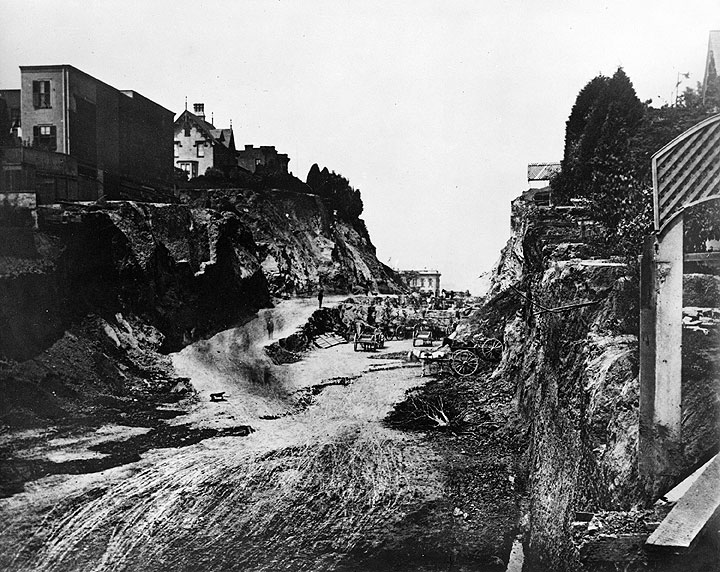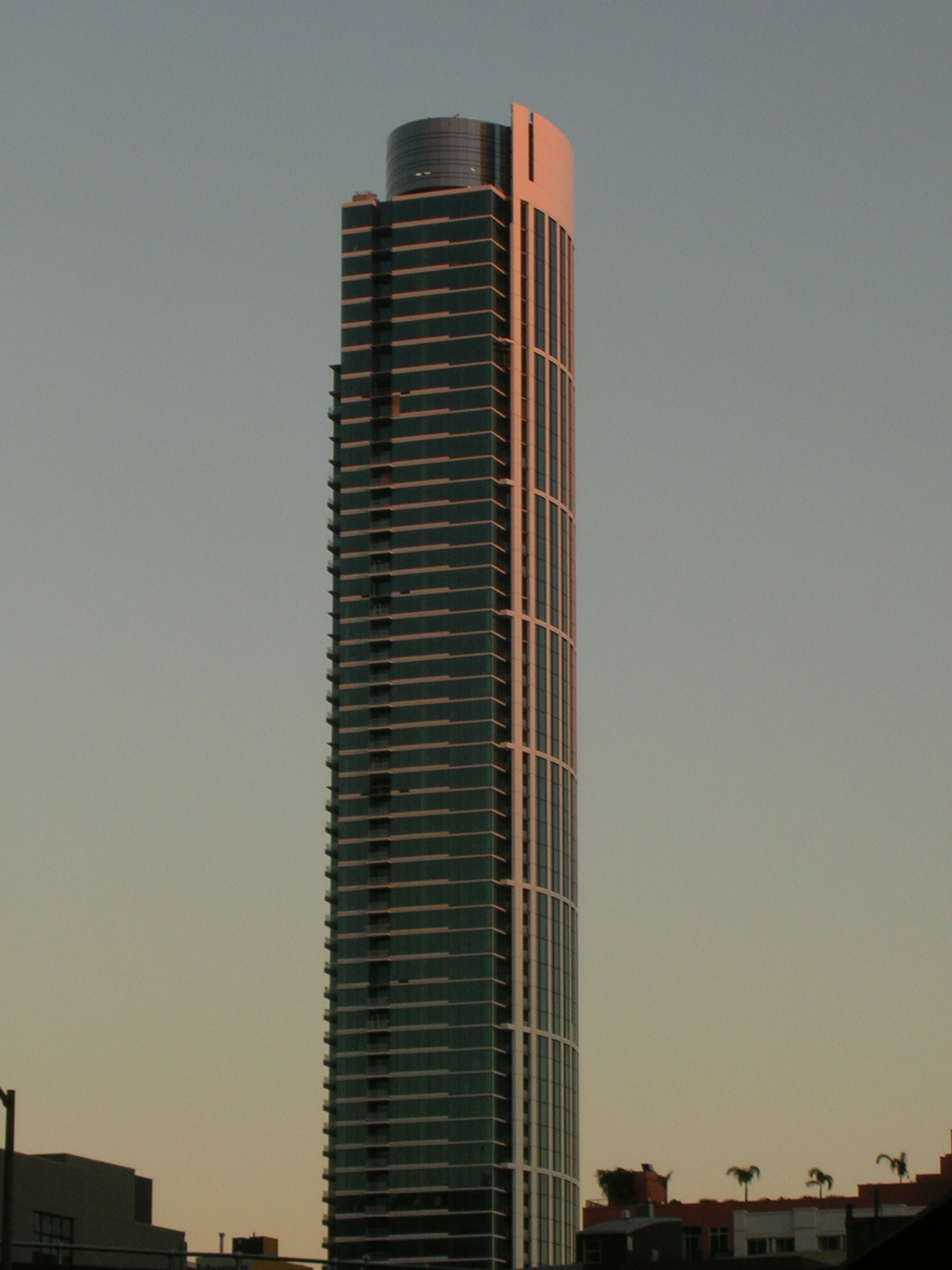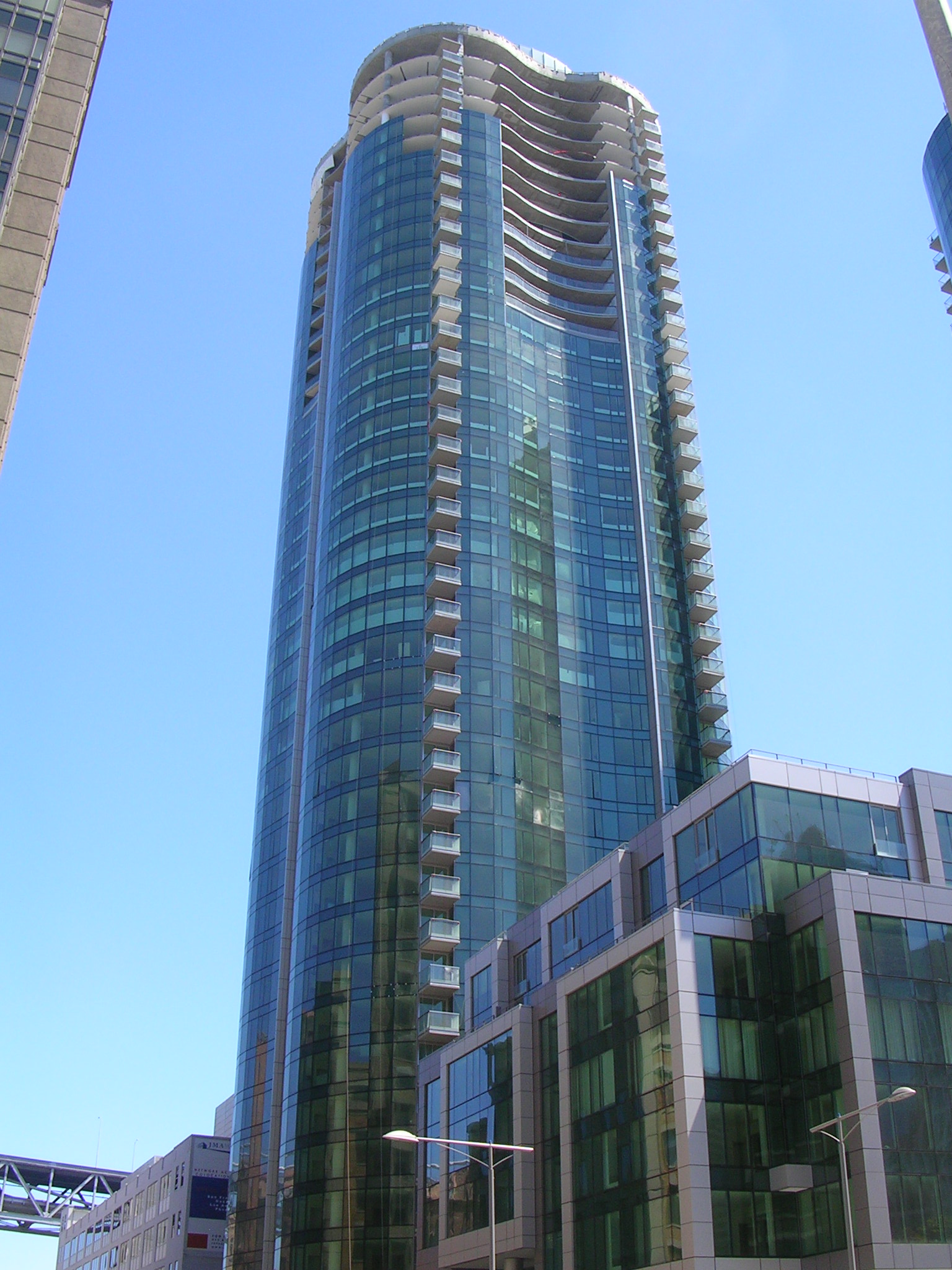Rincon Hill on:
[Wikipedia]
[Google]
[Amazon]
Rincon Hill is a neighborhood in
 With the advent of cable cars in the 1870s, the residential trend shifted towards new mansions built on the taller hills north of
With the advent of cable cars in the 1870s, the residential trend shifted towards new mansions built on the taller hills north of
 The construction of the
The construction of the  With new vehicular access to the East Bay, the area was slowly built up as an industrial and maritime district, benefiting from its proximity to the Port of San Francisco and the Southern Pacific rail yards in Mission Bay. In 1934, Rincon Hill was the site of the "Bloody Thursday" clashes between striking longshoreman and police, in which two maritime workers were killed, leading to a four-day general strike.
In the 1950s, the Embarcadero Freeway was constructed along Folsom Street, surrounding the neighborhood on three sides by freeway ramps, and cutting it off from the Financial District. As the city's industrial and maritime industries declined (as in most U.S. cities), the area became underutilized and rundown. From the 1960s to the mid-1980s, while the nearby Financial District was built up with dozens of new office skyscrapers, the Rincon Hill area was largely ignored.
With new vehicular access to the East Bay, the area was slowly built up as an industrial and maritime district, benefiting from its proximity to the Port of San Francisco and the Southern Pacific rail yards in Mission Bay. In 1934, Rincon Hill was the site of the "Bloody Thursday" clashes between striking longshoreman and police, in which two maritime workers were killed, leading to a four-day general strike.
In the 1950s, the Embarcadero Freeway was constructed along Folsom Street, surrounding the neighborhood on three sides by freeway ramps, and cutting it off from the Financial District. As the city's industrial and maritime industries declined (as in most U.S. cities), the area became underutilized and rundown. From the 1960s to the mid-1980s, while the nearby Financial District was built up with dozens of new office skyscrapers, the Rincon Hill area was largely ignored.
 While its potential for housing development has long been recognized due to its proximity to downtown, blight prevented its effective redevelopment. In 1985, the city adopted an area plan for Rincon Hill in the city's General Plan, zoning this area adjacent to downtown for high-density residential development. However, due to the presence of the former elevated Embarcadero Freeway surrounding the neighborhood, development in the area was slow in coming, suffered from mediocre architecture, and lacked the pedestrian-oriented streets and open spaces emblematic of San Francisco's cherished neighborhoods. As the city later noted, "Rincon Hill has seen the construction of bulky, closely spaced residential towers, which block public views, crowd streets, and contribute to a flat, unappealing skyline. These developments have also contributed little to the pedestrian environment, with multiple levels of above-ground parking, and garage entries and featureless walls facing the street."
While its potential for housing development has long been recognized due to its proximity to downtown, blight prevented its effective redevelopment. In 1985, the city adopted an area plan for Rincon Hill in the city's General Plan, zoning this area adjacent to downtown for high-density residential development. However, due to the presence of the former elevated Embarcadero Freeway surrounding the neighborhood, development in the area was slow in coming, suffered from mediocre architecture, and lacked the pedestrian-oriented streets and open spaces emblematic of San Francisco's cherished neighborhoods. As the city later noted, "Rincon Hill has seen the construction of bulky, closely spaced residential towers, which block public views, crowd streets, and contribute to a flat, unappealing skyline. These developments have also contributed little to the pedestrian environment, with multiple levels of above-ground parking, and garage entries and featureless walls facing the street."
 After the physical and psychological barrier of the Embarcadero Freeway (damaged in the
After the physical and psychological barrier of the Embarcadero Freeway (damaged in the
Rincon Hill Plan
ˆ’
California Historic Landmark 84 plaque at Bryant and Rincon Streets
One Rincon Hill Project on top of Rincon Hill
Possible future views of the hill
{{Authority control Geography of San Francisco Hills of San Francisco History of San Francisco Landmarks in California Landmarks in San Francisco Neighborhoods in San Francisco South of Market, San Francisco 1906 San Francisco earthquake
San Francisco
San Francisco (; Spanish language, Spanish for "Francis of Assisi, Saint Francis"), officially the City and County of San Francisco, is the commercial, financial, and cultural center of Northern California. The city proper is the List of Ca ...
, California
California is a U.S. state, state in the Western United States, located along the West Coast of the United States, Pacific Coast. With nearly 39.2million residents across a total area of approximately , it is the List of states and territori ...
. It is one of San Francisco's many hills, and one of its original " Seven Hills." The relatively compact neighborhood is bounded by Folsom Street to the north, the Embarcadero to the east, Bryant Street on the south, and Essex Street to the west. Named after Rincon Point that formerly extended into the bay there, Rincon Hill is located just south of the Transbay development area, part of the greater South of Market
South of Market (SoMa) is a neighborhood in San Francisco, California, situated just south of Market Street. It contains several sub-neighborhoods including South Beach, Yerba Buena, and Rincon Hill.
SoMa is home to many of the city's museums ...
area. The hill is about 100 feet (30 m) tall.
Following the California Gold Rush
The California Gold Rush (1848–1855) was a gold rush that began on January 24, 1848, when gold was found by James W. Marshall at Sutter's Mill in Coloma, California. The news of gold brought approximately 300,000 people to California fro ...
, Rincon Hill was built up as a fashionable and prestigious residential neighborhood. After it was destroyed by the 1906 earthquake and fire, the neighborhood was slow to rebuild and largely became an industrial area with small factories and warehouses. In 1985, and revised in 2005, the area was rezoned into a high-density residential neighborhood designed to house up to 10,000 new residents in close proximity to the city's Financial District.
History
The area comprising Rincon Hill was originally a sandy peninsula forming the southern shoreline of Yerba Buena Cove. The peninsula terminated at Rincon Point, near Harrison and Spear streets, from which Rincon Hill derives its name. ''Rincón'' is Spanish for "corner", and the point formed the southern corner of the cove. Prior to theGold Rush
A gold rush or gold fever is a discovery of gold—sometimes accompanied by other precious metals and rare-earth minerals—that brings an onrush of miners seeking their fortune. Major gold rushes took place in the 19th century in Australia, New Z ...
of 1849, the Rincon Hill area was largely unsettled, as most early development was on the north side of the Cove, near Portsmouth Square
Portsmouth ( ) is a port and city in the ceremonial county of Hampshire in southern England. The city of Portsmouth has been a unitary authority since 1 April 1997 and is administered by Portsmouth City Council.
Portsmouth is the most densel ...
.
Gold Rush to the 1906 quake
With the influx of gold seekers, the cove was filled in and the street grid expanded. Rincon Hill's views and sunny climate made it attractive to families of merchants, sea captains, and other professional classes who sought refuge from the notorious Barbary Coast. During the 1850s and 1860s, the city's most prestigious residential neighborhoods were located south of Market Street on Rincon Hill and in the nearby neighborhood known as ''Happy Valley'' (centered around First and Market Streets). The Second Street Cut of 1869, which sliced through Rincon Hill to reach industrial areas to the south, marked the beginning of the end of Rincon Hill as a fashionable residential area. A wealthy land owner and state assemblyman, John Middleton, proposed the leveling of Second Street through Rincon Hill to improve access to the city's southern waterfront. The canyon split Rincon Hill in two and destabilized homes on either side. With the advent of cable cars in the 1870s, the residential trend shifted towards new mansions built on the taller hills north of
With the advent of cable cars in the 1870s, the residential trend shifted towards new mansions built on the taller hills north of Market Street Market Street may refer to:
*Market Street, Cambridge, England
*Market Street, Fremantle, Western Australia, Australia
* Market Street, George Town, Penang, Malaysia
*Market Street, Manchester, England
*Market Street, Melbourne, Victoria, Australia
...
, especially Nob Hill
Nob Hill is a neighborhood of San Francisco, California, United States that is known for its numerous luxury hotels and historic mansions. Nob Hill has historically served as a center of San Francisco's upper class. Nob Hill is among the highes ...
. In '' The Wrecker'' (1892), Robert Louis Stevenson
Robert Louis Stevenson (born Robert Lewis Balfour Stevenson; 13 November 1850 – 3 December 1894) was a Scottish novelist, essayist, poet and travel writer. He is best known for works such as ''Treasure Island'', ''Strange Case of Dr Jekyll a ...
described Rincon Hill as "a new slum, a place of precarious sandy cliffs, deep sandy cuttings, solitary ancient houses and butt ends of streets."
Decline and industrial transition
The 1906 earthquake and fire destroyed the remaining Rincon Hill mansions. In their place, a number of rudimentary earthquake shacks sprung up and remained for decades. While much of San Francisco was quickly rebuilt following the earthquake, Rincon Hill remained relatively undeveloped in the ensuing decades. Following the quake, theMarsden Manson
Marsden Manson (1850–1931) was a civil engineer
A civil engineer is a person who practices civil engineering – the application of planning, designing, constructing, maintaining, and operating infrastructure while protecting the public and ...
report on reconstruction recommended that Rincon Hill be removed entirely to provide more flat ground close to the waterfront. Although the plan was never enacted, it resurfaced in 1913 and 1927, discouraging real estate developers from building on the hill.
 The construction of the
The construction of the San Francisco–Oakland Bay Bridge
The San Francisco–Oakland Bay Bridge, known locally as the Bay Bridge, is a complex of bridges spanning San Francisco Bay in California. As part of Interstate 80 in California, Interstate 80 and the direct road between San Francisco and Oakland ...
in the 1930s cleared out the remaining shacks, transforming the landscape of the neighborhood yet again. While the bridge was under construction, Rincon Hill was recognized as a California Historical Landmark
A California Historical Landmark (CHL) is a building, structure, site, or place in California that has been determined to have statewide historical landmark significance.
Criteria
Historical significance is determined by meeting at least one of ...
in 1933, with the plaque reading in part:
 With new vehicular access to the East Bay, the area was slowly built up as an industrial and maritime district, benefiting from its proximity to the Port of San Francisco and the Southern Pacific rail yards in Mission Bay. In 1934, Rincon Hill was the site of the "Bloody Thursday" clashes between striking longshoreman and police, in which two maritime workers were killed, leading to a four-day general strike.
In the 1950s, the Embarcadero Freeway was constructed along Folsom Street, surrounding the neighborhood on three sides by freeway ramps, and cutting it off from the Financial District. As the city's industrial and maritime industries declined (as in most U.S. cities), the area became underutilized and rundown. From the 1960s to the mid-1980s, while the nearby Financial District was built up with dozens of new office skyscrapers, the Rincon Hill area was largely ignored.
With new vehicular access to the East Bay, the area was slowly built up as an industrial and maritime district, benefiting from its proximity to the Port of San Francisco and the Southern Pacific rail yards in Mission Bay. In 1934, Rincon Hill was the site of the "Bloody Thursday" clashes between striking longshoreman and police, in which two maritime workers were killed, leading to a four-day general strike.
In the 1950s, the Embarcadero Freeway was constructed along Folsom Street, surrounding the neighborhood on three sides by freeway ramps, and cutting it off from the Financial District. As the city's industrial and maritime industries declined (as in most U.S. cities), the area became underutilized and rundown. From the 1960s to the mid-1980s, while the nearby Financial District was built up with dozens of new office skyscrapers, the Rincon Hill area was largely ignored.
High-density residential neighborhood
1989 Loma Prieta earthquake
The 1989 Loma Prieta earthquake occurred on California's Central Coast on October 17 at local time. The shock was centered in The Forest of Nisene Marks State Park in Santa Cruz County, approximately northeast of Santa Cruz on a section of t ...
) was removed in the early 1990s, the area within walking distance of downtown gained new attractiveness. In August 2005, the City adopted a new Rincon Hill Plan, based more on Vancouverism
Vancouverism is an urban planning and architectural phenomenon in Vancouver, British Columbia, Canada. It is characterized by a large residential population living in the city centre with mixed-use developments, typically with a medium-height, c ...
than the 1985 Plan, that emphasizes tall, slender, and widely spaced towers, interspaced with mid-rise podiums and walk-up townhouses. It aims to accentuate the natural topography of the city by locating the tallest skyscrapers at the top of Rincon Hill. In tandem with the Transbay development plan just to the north, it designates Folsom Street as the commercial heart of the neighborhood. The plan calls for improving the pedestrian experience by narrowing the streets to provide more open space and providing more midblock passages.
Whereas the 1985 plan capped buildings heights at , the new Rincon Hill Plan raised a number of height limits near the peak of Rincon Hill to 400 and . Although a number of new residential developments were approved to take advantage of the changes, only The Infinity and one tower of 709-unit One Rincon Hill were constructed before the 2008 financial crisis
8 (eight) is the natural number following 7 and preceding 9.
In mathematics
8 is:
* a composite number, its proper divisors being , , and . It is twice 4 or four times 2.
* a power of two, being 2 (two cubed), and is the first number of t ...
halted projects throughout the city. As the economy recovered, the second tower of One Rincon Hill began construction in 2012; the 320-unit 45 Lansing Street and 655-unit LUMINA broke ground in 2013; and the 447-unit 399 Fremont Street
399 Fremont Street is a residential skyscraper in the Rincon Hill, San Francisco, Rincon Hill neighborhood of San Francisco, California. The tower has 447 residential units on 42 floors, and of amenity space.
History
As part of the Rincon Hil ...
started in 2014.
In July 2015, property owners voted to approve of the formation of the Greater Rincon Hill Community Benefit District, a non-profit, public-private partnership focused on advancing the neighborhood's quality of life, enhancing its public realm, and reinforcing the viability of its economic base. In 2017, to more accurately reflect the district boundaries and to unite the Rincon Hill, Folsom Street, and Transbay areas, the non-profit's name was changed to the East Cut Community Benefit District.
See also
* List of tallest buildings in San Francisco for more information about new Rincon Hill skyscrapers. *List of San Francisco, California Hills
This is a list of the hills of San Francisco, California.
Prior lists
Several cities claim to have been built on seven hills. "The Seven Hills of San Francisco" are Telegraph Hill, Nob Hill, Russian Hill, Rincon Hill, Twin Peaks, Mount Davidso ...
References
External links
Rincon Hill Plan
ˆ’
California Historic Landmark 84 plaque at Bryant and Rincon Streets
One Rincon Hill Project on top of Rincon Hill
Possible future views of the hill
{{Authority control Geography of San Francisco Hills of San Francisco History of San Francisco Landmarks in California Landmarks in San Francisco Neighborhoods in San Francisco South of Market, San Francisco 1906 San Francisco earthquake